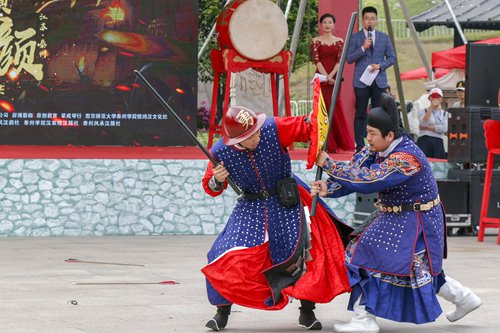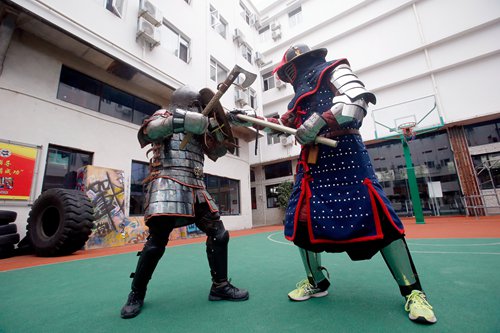
Medieval Combat Sport (MCS) and Historical Medieval Battles (HMB) are modern takes on ancient fighting techniques, and tournaments featuring the ancient combat forms first emerged in Eastern Europe 20 years ago. The sport evolved from Roman gladiator culture and medieval knight traditions.
Full contact fighting with armor, known as Buhurt, has emerged in China.
In 2017, a Chinese team participated in their first international competition with Ming Dynasty-styled armor and swords.
Chinese competitors wear ancient battle armor from various dynasties, preserving history while educating younger generations.
The armor recreation is an entry point for others to learn about Chinese military history and how the art of war evolved through the dynasties.
Buhurt has become more popular in China in recent years, starting as a website for collectors to show off their weapons and gradually evolving into the first private organization for Buhurt nationwide called SHMA.
"As cool as it looks, few people are really into the sport due to its high threshold," said SHMA President, Chen Jia.
Today’s Story in the Story looks at Buhurt, the latest sport to emerge in China, one that combines ancient Chinese history and traditional combat techniques.

Two men wearing Ming Dynasty (1368-1644) armor take part in a close combat competition on April 22. 2018, in Taizhou, Jiangsu Province. (Photo: Global Times)
"The First Year of Armor" was held by the Armor Alliance in Hailongtun, Southwest China's Guizhou Province on October 10, 2018.
Armor fans from all over China gathered to share their love of traditional martial-arts culture with festival-goers.
While Chinese armor was meant for war, it was not without its artistic value. The craftsmanship and design of the armor featuring lotus flowers, phoenix's wings, clouds and beast heads are symbols of Chinese culture.
The differences in armor reveal the main events from different historical periods. Heavy cavalry armor used during the Sui (581-618) and Tang (618-907) dynasties, represent the important role of horse mounted battle. After the invasion of light cavalry from northern nomadic people during the Song Dynasty (960-1279), heavy cavalry lost their advantage.
The reinforced infantry armor from the Song Dynasty reflects that lessening importance of heavy cavalry and the rise of foot power.
In 2017, the 8th Battle of the Nations was held in Barcelona, Spain.
Chinese warriors attended the competition wearing armor from the Ming Dynasty (1368-1644) and were armed with Green Dragon crescent blades, a sword that was characteristic of this period. The occasion marked the first time Chinese armor and weapons appeared in international competition.
Although the Chinese team didn't get far in the tournament due to a lack of experience with such events, their appearance helped spread Chinese armor and weaponry culture throughout the world.

Two Buhurt lovers prepare for a combat training session in Shanghai. (Photo: Global Times)
Kang Lu, a Buhurt enthusiast, said that compared with the professional training that foreign players, especially those in Russia undergo gave them at a definite advantage.
Those who wish to participate must have a significant disposable income. Owning a set of armor is not affordable and is actually a luxury, just as it was in medieval times when knights required kings to sponsor them.
Participants must also be in strong physical shape, as the armor weighs several dozen kilograms.
Based on these factors, Chen said only the most die-hard fans will ever invest so much money and time on it.
Since the sport is still relatively new to China, the Chinese players lacked the training needed to compete during their first international tournament. Especially when it came to group battles, which are one of the most attractive facets of the sport.
The team battles require very specific strategies and tactics, skills that can only be acquired through group training.
Considering that most of the players in China are scattered in different cities, this makes group training difficult. And traveling is also a concern, especially when it comes to security as there are strict regualtions carrying armor and weapons aboard flights and trains.
"If we run into this problem, we have to talk to the police and show them reports about the sport. We have to convince them that our armor and weapons are for competition only and are not used to hurt others," Kang explained.
Another obstacle is the Chinese armor as it is heavier than their Western opponents armor, which is made with flexible titanium alloy.
Kang Lu and other armor fans are working to get Buhurt registered with China's Sports Bureau.
"From the bottom of our hearts, we all hope Full Contact Fighting in Armor can become an Olympic sport or even just a performance discipline. Then we will be able to show Chinese history and culture to the whole world," he noted.
(Produced by Nancy Yan Xu, Lance Crayon, Brian Lowe, and Chelle Wenqian Zeng. Music by: bensound.com. Text from Global Times)


